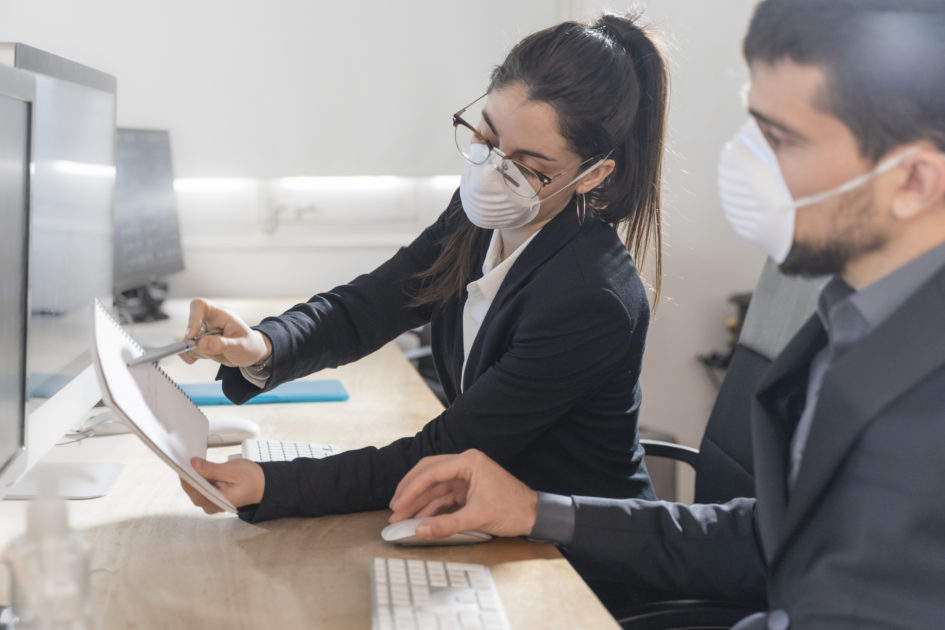When Stay At Home orders are lifted and many get back to work in person, it can be hard to know where to start.
All employers need to consider how best to decrease the spread of COVID-19 and lower the impact in their workplace. This may include activities in one or more of the following areas:
Reduce Transmission Amongst Employees
Actively encourage sick employees to stay home:
- Employees who have symptoms (i.e., fever, cough, or shortness of breath) should notify their supervisor and stay home.
- Sick employees should not return to work until the criteria to discontinue home isolation are met, in consultation with healthcare providers and state and local health departments.
- Employees who are well but who have a sick family member at home with COVID-19 should notify their supervisor and follow CDC recommended precautions.
- If an employee is confirmed to have COVID-19 infection, employers should inform fellow employees of their possible exposure to COVID-19 in the workplace but maintain confidentiality as required by the Americans with Disabilities Act (ADA).
Maintain Healthy Business Operations
Identify a workplace coordinator who will be responsible for COVID-19 issues and their impact at the workplace.
Implement flexible sick leave and supportive policies and practices.
- Ensure that sick leave policies are flexible and consistent with public health guidance and that employees are aware of and understand these policies.
- Maintain flexible policies that permit employees to stay home to care for a sick family member or take care of children due to school and childcare closures.
- Employers should not require a positive COVID-19 test result or a healthcare provider’s note for employees who are sick to validate their illness, qualify for sick leave, or to return to work.
- Connect employees to employee assistance program (EAP) resources (if available) and community resources as needed. Employees may need additional social, behavioral, and other services, for example, to cope with the death of a loved one.
Consider establishing policies and practices for social distancing. Strategies that business could use include:
- Implementing flexible worksites (e.g., telework)
- Implementing flexible work hours (e.g., staggered shifts)
- Increasing physical space between employees at the worksite
- Increasing physical space between employees and customers (e.g., drive through, partitions)
- Implementing flexible meeting and travel options (e.g., postpone non-essential meetings or events)
- Downsizing operations
- Delivering services remotely (e.g. phone, video, or web)
- Delivering products through curbside pick-up or delivery
Maintain a Healthy Work Environment
Consider improving the engineering controls using the building ventilation system. This may include some or all of the following activities:
- Increase ventilation rates.
- Increase the percentage of outdoor air that circulates into the system.
Support respiratory etiquette and hand hygiene for employees, customers, and worksite visitors:
- Provide tissues and no-touch disposal receptacles.
- Provide soap and water in the workplace. If soap and water are not readily available, use alcohol-based hand sanitizer that is at least 60% alcohol. If hands are visibly dirty, soap and water should be chosen over hand sanitizer. Ensure that adequate supplies are maintained.
- Place hand sanitizers in multiple locations to encourage hand hygiene.
- Place posters that encourage hand hygiene to help stop the spread at the entrance to your workplace and in other workplace areas where they are likely to be seen.
- Discourage handshaking – encourage the use of other noncontact methods of greeting.
- Direct employees to visit the coughing and sneezing etiquette and clean hands webpage for more information.
Perform routine environmental cleaning and disinfection:
- Routinely clean and disinfect all frequently touched surfaces in the workplace, such as workstations, keyboards, telephones, handrails, and doorknobs.
- Discourage workers from using other workers’ phones, desks, offices, or other work tools and equipment, when possible. If necessary, clean and disinfect them before and after use.
- Provide disposable wipes so that commonly used surfaces (for example, doorknobs, keyboards, remote controls, desks, other work tools and equipment) can be wiped down by employees before each use.

